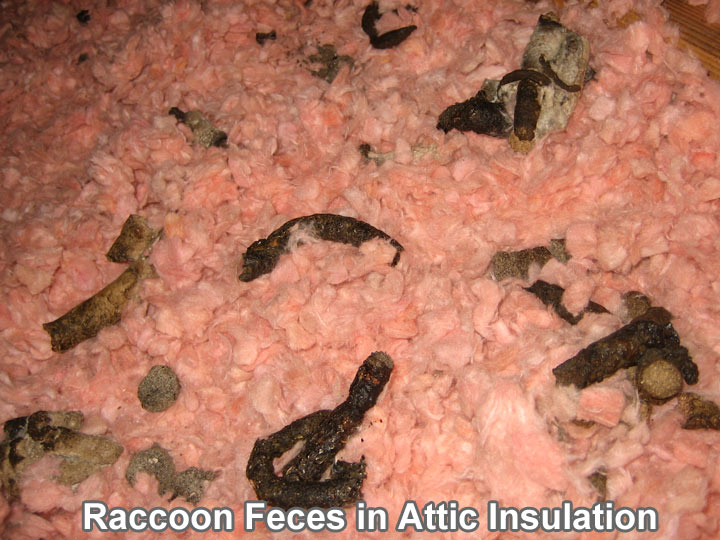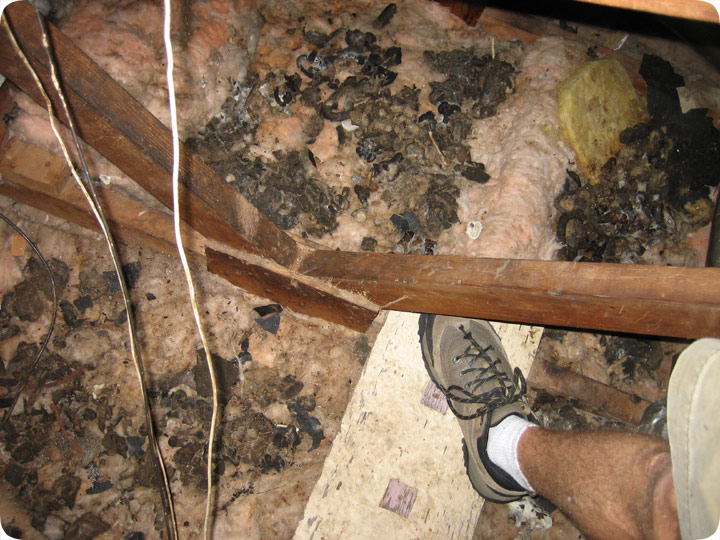The raccoons living in your attic use the attic as a latrine, depositing their waste, including food debris, urine, and most noticeable of all, raccoon droppings. Sometimes
they leave their feces concentrated in a tight area, a small raccoon latrine, but most of the time they just go wherever, and the poop is spread out all over the attic. Look
at the below photographs of raccoon feces and you will be able to tell if the droppings in your attic came from a raccoon or some other animal.

This is a photograph of raccoon fecal contamination inside an attic. Do not touch raccoon feces.
You will notice that raccoon poop is cylindrical, brown of course, and the best telltale sign is the presence of berries in the feces. For some reason, a high percentage of coon poop contains these berries, which don't fully digest, and are visible. If you are in doubt about what kind of animal made the waste, you can email me, or your can call out a local raccoon pro in your area to inspect and tell you what animal you have. In fact, even if you know it's raccoons leaving the toilet up there, you still ought to call out a licensed and experienced professional, because removal of raccoons from attics is not easy.
Learn how to Identify Raccoon Tracks.
Concerns regarding raccoon droppings - Raccoon poop resembles that of a small dog’s. As stated, if you’ve noticed berries in the fecal material, you can almost be certain it belongs to a raccoon. Take extra care with raccoon droppings, - gloves, HEPA filter mask, and look around in the right spots, where you've heard the animals. These animals often have a latrine, or an area where they prefer to expel waste. You must remove raccoon droppings by hand. Using a vacuum or broom can push dangerous particles into the air. This particular animal is known for its ability to spread roundworm, an intestinal parasite that can be transmitted to both people and animals. Round worm can enter the body through a number of ways but it most commonly ingested when eggs are transferred to the mouth by unwashed hands. If you’re cleaning an attic or building from a raccoon infestation, you absolutely need to wear protective gear. Not only does raccoon poop pose a significant risk to your health, raccoon urine can carry leptospirosis, a bacterial infection that destroys kidney function. If you’re not worried about the roundworm, giardia is also a major concern. Many animals carry giardia, but if you happen to catch it and have a compromised immune system, you might be dealing with some unpleasant diarrhea and gastrointestinal upset.
NEED LOCAL HELP? We have wildlife removal professionals servicing 95% of the USA. Click here to hire a local raccoon removal expert in your home town. Updated 2018. But read the below advice first!
What to do about raccoon feces in attic - You can never leave raccoon feces in an attic. You’re probably aware of that fact, but you might not realize just what that means as far as cleaning. Not only do you need to pick up each piece of poop by hand, you need to sanitize any surface that came in contact with it. If the droppings were on insulation, that insulation needs to be pulled up and thrown away. Leaving it in the attic will only result in the growth of bacteria and spores. These can become airborne and can then be inhaled by you or a member of your family. Worst of all is raccoon roundworm eggs, which you can also breathe in and become infected by. This is also the reason why you can’t use a broom or a vacuum to clean up the droppings. Stirring up too much air will thrust dangerous particles into the air. In reality, if you’re going to be doing the attic cleaning on your own, you should be wearing a respirator mask, eye protection, gloves, and a biohazard suit that can be thrown away afterward. Many wildlife removal companies also offer a cleaning service. If you want to be hands-free with the entire process, look for a company that will trap and relocate the raccoons as well as take care of the mess afterward.

Here is a raccoon latrine in an attic, showing high usage and a lot of raccoon feces.
Wildlife feces cleanup - Cleaning up after wildlife is one of the most important parts of taking care of your home after an infestation. There will be damage for sure, but it’s the fecal material and liquid waste that will cause more serious issues down the road. Whenever you are dealing with feces, you need to remember not stir up too much dust while cleaning. It’s the microscopic particles in feces that are dangerous to people, and it doesn’t take much for those particles to become airborne. Animal feces, even that of small critters, is best removed by hand. Resist the urge to use the vacuum cleaner or the broom. If you’re wearing proper protective gear you’ll be able to handle the waste with no issue. It may take you longer, but consider it a lesson for keeping you house in a better state of repair. An animal has to find a way in, first, and a way in usually happens because a part of the building is damaged. Once you’ve cleaned up all the fecal material, you have to remove the building items it was touching—within reason. Do not try to salvage any insulation. Leaving the soiled insulation behind will just promote the growth of mold and spread of pathogens. Click here to learn everything about how to get rid of raccoons in the attic, from the web's best guide.

This is a photograph of raccoon fecal contamination inside an attic. Do not touch raccoon feces.
You will notice that raccoon poop is cylindrical, brown of course, and the best telltale sign is the presence of berries in the feces. For some reason, a high percentage of coon poop contains these berries, which don't fully digest, and are visible. If you are in doubt about what kind of animal made the waste, you can email me, or your can call out a local raccoon pro in your area to inspect and tell you what animal you have. In fact, even if you know it's raccoons leaving the toilet up there, you still ought to call out a licensed and experienced professional, because removal of raccoons from attics is not easy.
Learn how to Identify Raccoon Tracks.
Concerns regarding raccoon droppings - Raccoon poop resembles that of a small dog’s. As stated, if you’ve noticed berries in the fecal material, you can almost be certain it belongs to a raccoon. Take extra care with raccoon droppings, - gloves, HEPA filter mask, and look around in the right spots, where you've heard the animals. These animals often have a latrine, or an area where they prefer to expel waste. You must remove raccoon droppings by hand. Using a vacuum or broom can push dangerous particles into the air. This particular animal is known for its ability to spread roundworm, an intestinal parasite that can be transmitted to both people and animals. Round worm can enter the body through a number of ways but it most commonly ingested when eggs are transferred to the mouth by unwashed hands. If you’re cleaning an attic or building from a raccoon infestation, you absolutely need to wear protective gear. Not only does raccoon poop pose a significant risk to your health, raccoon urine can carry leptospirosis, a bacterial infection that destroys kidney function. If you’re not worried about the roundworm, giardia is also a major concern. Many animals carry giardia, but if you happen to catch it and have a compromised immune system, you might be dealing with some unpleasant diarrhea and gastrointestinal upset.
NEED LOCAL HELP? We have wildlife removal professionals servicing 95% of the USA. Click here to hire a local raccoon removal expert in your home town. Updated 2018. But read the below advice first!
What to do about raccoon feces in attic - You can never leave raccoon feces in an attic. You’re probably aware of that fact, but you might not realize just what that means as far as cleaning. Not only do you need to pick up each piece of poop by hand, you need to sanitize any surface that came in contact with it. If the droppings were on insulation, that insulation needs to be pulled up and thrown away. Leaving it in the attic will only result in the growth of bacteria and spores. These can become airborne and can then be inhaled by you or a member of your family. Worst of all is raccoon roundworm eggs, which you can also breathe in and become infected by. This is also the reason why you can’t use a broom or a vacuum to clean up the droppings. Stirring up too much air will thrust dangerous particles into the air. In reality, if you’re going to be doing the attic cleaning on your own, you should be wearing a respirator mask, eye protection, gloves, and a biohazard suit that can be thrown away afterward. Many wildlife removal companies also offer a cleaning service. If you want to be hands-free with the entire process, look for a company that will trap and relocate the raccoons as well as take care of the mess afterward.

Here is a raccoon latrine in an attic, showing high usage and a lot of raccoon feces.
Wildlife feces cleanup - Cleaning up after wildlife is one of the most important parts of taking care of your home after an infestation. There will be damage for sure, but it’s the fecal material and liquid waste that will cause more serious issues down the road. Whenever you are dealing with feces, you need to remember not stir up too much dust while cleaning. It’s the microscopic particles in feces that are dangerous to people, and it doesn’t take much for those particles to become airborne. Animal feces, even that of small critters, is best removed by hand. Resist the urge to use the vacuum cleaner or the broom. If you’re wearing proper protective gear you’ll be able to handle the waste with no issue. It may take you longer, but consider it a lesson for keeping you house in a better state of repair. An animal has to find a way in, first, and a way in usually happens because a part of the building is damaged. Once you’ve cleaned up all the fecal material, you have to remove the building items it was touching—within reason. Do not try to salvage any insulation. Leaving the soiled insulation behind will just promote the growth of mold and spread of pathogens. Click here to learn everything about how to get rid of raccoons in the attic, from the web's best guide.